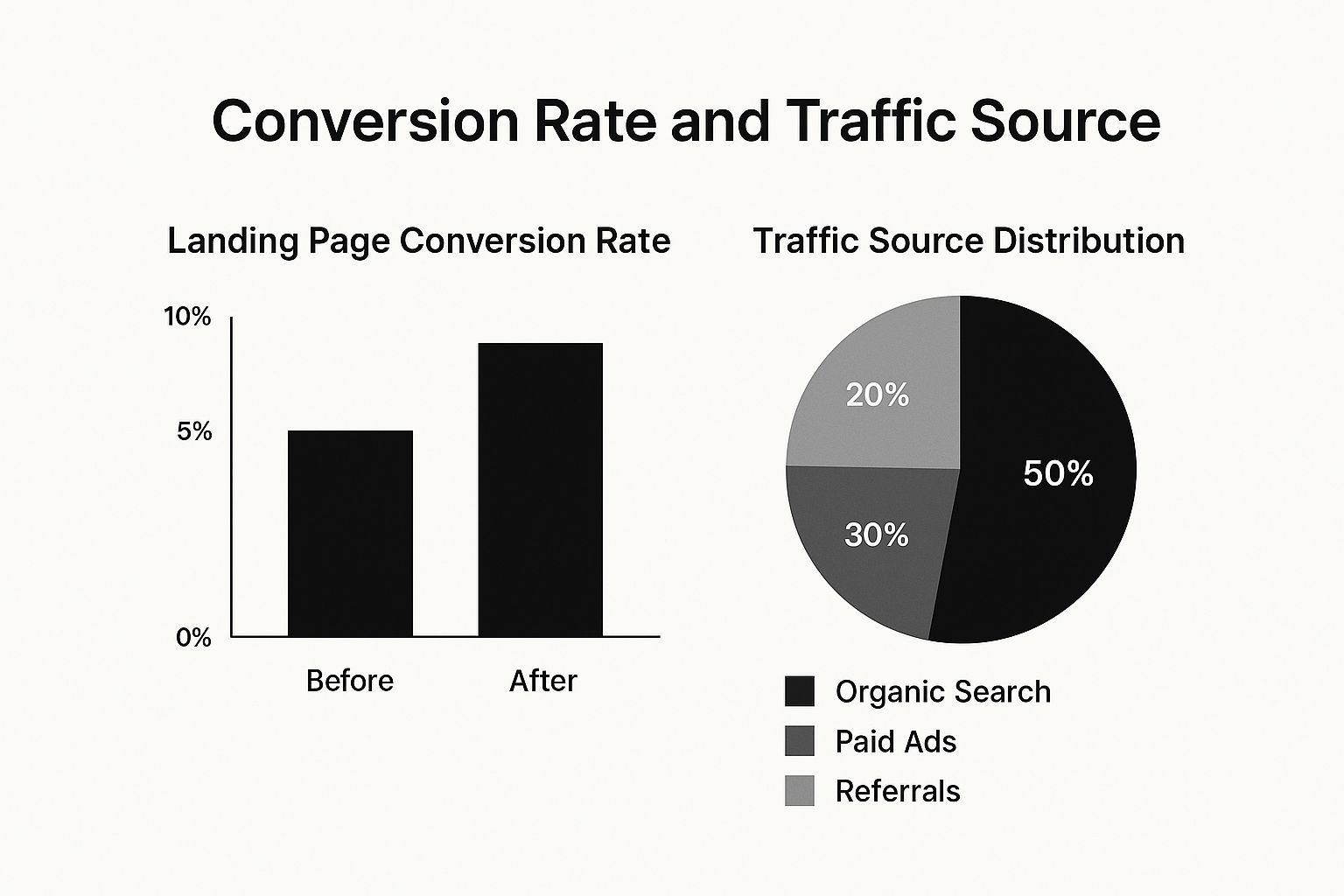Trying to generate leads for your IT services without a solid foundation is a recipe for wasted time and money. It's not about just grabbing a list of contacts and firing off emails. It's about building a predictable, repeatable system that consistently brings in high-value opportunities.
Before you even think about outreach, you need to lay the groundwork. This ensures every move you make is targeted, measurable, and built for the best possible return.
Building Your Foundation for Predictable Leads

Jumping straight into outreach without a clear strategy is like trying to build a network without a blueprint. Sure, you might make a few random connections, but they won't be stable or scalable.
The first real step in any successful campaign is to build this strategic foundation. This is where you move away from guesswork and start making decisions based on data, ensuring your efforts are focused, efficient, and ultimately, profitable.
Define Your Ideal Customer Profile
Generic buyer personas are okay, but for IT services, you need to get much more specific with an Ideal Customer Profile (ICP). This isn't just a description of the decision-maker; it's a detailed picture of the company you want as a client. It’s a critical distinction that will shape your entire approach.
Your ICP needs to dig deep into firmographic and technographic details. Ask yourself:
- Company Size: Are you targeting SMBs with 50-100 employees, or are you equipped for enterprise clients with thousands?
- Industry Vertical: Do you have specialized experience in healthcare, finance, or manufacturing?
- Existing Infrastructure: What tech are they already using? Is their setup on-premise, cloud-based, or a hybrid model?
- Technical Pain Points: What are the recurring IT headaches they face? Think specific problems like cybersecurity vulnerabilities, messy data management, or clunky legacy systems.
- Business Goals: What are they trying to achieve? Are they looking to scale operations, cut overhead, or tighten up compliance?
Getting this level of detail means your messaging will hit home, addressing the exact problems your IT services can solve. Your outreach instantly becomes more relevant and effective.
Conduct Pointed Market Research
Once you know who you're targeting, you need to figure out where they are and what the competitive landscape looks like. This isn't about reading broad industry reports; it's about finding your specific corner of the market.
Remember, research shows that 71% of B2B buyers look at multiple pieces of content before they even think about engaging. You need to understand their world.
Look for underserved segments or specific pain points that your bigger competitors are ignoring. This clarity helps you tailor your services and marketing messages so you don't just blend into the noise.
Establish Your Key Performance Indicators
Finally, you have to define what success actually looks like before you start. Setting non-negotiable Key Performance Indicators (KPIs) is what turns your lead generation from a cost centre into a measurable growth engine.
While the fundamentals of what lead generation is are universal, the metrics you track have to be specific to your business.
A few key KPIs you need to establish upfront include:
- Cost Per Lead (CPL): The absolute most you can afford to spend to get a single qualified lead.
- Customer Lifetime Value (CLV): The total revenue you can realistically expect from a client over your entire relationship.
- Conversion Rate: The percentage of leads that actually sign on as paying customers.
Knowing these numbers from the get-go will guide every decision you make, from the outreach channels you choose to the budget you set. It’s how you build a lead generation for IT services program on a foundation of predictability and profitability.
Choosing the Right Channels for B2B Tech
Blanket-spamming every platform out there is a rookie mistake. It’s a fast track to burning through your budget and, worse, souring relationships with potential clients. When you’re selling IT services, you need a surgical approach. The real goal is to figure out exactly where your ideal decision-makers are hanging out and meet them there.
It’s about building a smart, multi-touch plan that makes you a persistent, valuable resource—not just more noise in their inbox. The idea isn't just to be present; it's to be impactful. A well-timed email, a thoughtful LinkedIn connection, and a quick, strategic phone call all work together. They build familiarity and, eventually, trust.
Designing a Multi-Touch Outreach Plan
Let's be real: a single channel is rarely enough to cut through the clutter in the B2B tech space. A CTO or IT Director gets bombarded with hundreds of pitches every single week. To even stand a chance, your strategy needs to be a coordinated effort across multiple channels, showing you respect their time while clearly demonstrating your value.
The most effective campaigns I've seen always weave together a few key channels:
- Targeted Email Campaigns: Ditch the generic templates. A good email should reference a specific company initiative, mention some recent news, or touch on a common challenge you know their industry is facing. Personalization is what separates a message that gets a reply from one that gets deleted.
- Personalized LinkedIn Outreach: Think of this as your digital handshake. Before you even think about hitting that "connect" button, engage with their posts, find some common ground, and write a message that proves you’ve actually done your homework. To get this right, you really need to understand the platform; it’s worth exploring different LinkedIn B2B lead generation strategies to see what clicks.
- Strategic Cold Calling: The cold call isn't dead, but it has definitely evolved. Forget the hard pitch. Instead, use these calls to qualify interest, gather a bit of intel, or simply set up a proper discovery meeting that follows up on your previous digital touchpoints. It’s a high-effort channel, for sure, but the reward can be huge.
This is all about creating a system where each part of your outreach supports the others.

As you can see, optimizing different elements—from your landing pages to where your traffic comes from—has a direct, measurable impact on your success. A holistic approach simply works better.
Why Account-Based Marketing is a Game Changer
For high-ticket IT services like managed security or major cloud migration projects, Account-Based Marketing (ABM) is incredibly powerful. Instead of casting a wide net and hoping to catch a few individual leads, ABM flips the script. You treat each target company as its own market.
This whole approach starts with a simple truth: big IT decisions are almost never made by one person. You’re dealing with a buying committee—the CTO, an IT Manager, maybe the Head of Security, and often the CFO who holds the purse strings.
This highly targeted strategy makes sure your value proposition resonates across the entire decision-making unit. It dramatically increases your odds of landing those larger, more complex deals. It's a fundamental shift from chasing leads to orchestrating opportunities.
Allocating Your Budget Effectively
Your budget should be a direct reflection of what you sell and who you sell it to. A firm specializing in cybersecurity for financial institutions is going to put their money in different places than one providing general IT support for local small businesses.
To help you get started, thinking through your options in a structured way can be a huge help.
Omnichannel Lead Generation Channel Comparison
Here’s a quick rundown of the top channels for IT services, breaking down what they’re best for and why you’d choose one over another.
table block not supported
Choosing where to spend your money isn’t just about picking a channel; it's about making every dollar count by making those channels work together.
For example, data from our work in California has shown time and again that an omnichannel approach delivers much higher engagement and is far more cost-effective. We’ve seen that multi-touch campaigns blending email, LinkedIn, and strategic calling consistently deliver 40% higher response rates and cut the cost-per-lead by 31%. An integrated strategy isn’t just a nice idea—it’s a financially sound one.
Using AI to Enhance Your Prospecting Efforts

Let's be honest: manual prospecting is a grind. The days of your best sales reps spending hours sifting through LinkedIn profiles and company websites are numbered. It's not just inefficient; it's a huge waste of talent.
This is where AI is changing the game. Bringing artificial intelligence into your prospecting workflow isn't just about a minor productivity boost—it’s about gaining a serious competitive edge. AI-powered tools are now at the heart of modern lead generation for IT services, helping you figure out which companies to talk to and when to make your move.
Automating the Grunt Work of Prospecting
The first and most obvious win with AI is getting rid of the mind-numbing research. Instead of a sales dev rep spending half their day just building a list, an AI platform can whip up a more accurate one in minutes.
You can dial in these tools to find companies that are a perfect match for your Ideal Customer Profile (ICP). Just set your parameters, such as:
- Industry and specific niches
- Company size and annual revenue
- The exact tech stack they’re currently using
- Recent hiring sprees or funding announcements
This frees your team to do what they're actually good at: building relationships and having strategic conversations. It's not about replacing salespeople; it’s about giving them supercharged, laser-focused data. For a deeper look into this, check out these applications of AI for Lead Generation.
Uncovering Buyer Intent Signals
This is where things get really interesting. One of the most powerful uses of AI in sales is its ability to analyze intent data. These platforms keep an eye on millions of online signals to pinpoint companies that are actively researching solutions just like yours.
Think of it as picking up on digital body language. An AI tool can flag an account when its team starts:
- Googling keywords related to your services (like "managed cybersecurity provider" or "cloud migration cost analysis").
- Checking out IT service vendors on review sites.
- Reading articles and white papers on topics you specialize in.
This kind of intelligence lets you focus your energy on accounts that have already raised their hands, dramatically boosting your chances of starting a real conversation.
Enabling Hyper-Personalization at Scale
Everyone knows personalization is crucial for cutting through the inbox noise, but trying to do it for hundreds of prospects is a recipe for burnout. AI platforms can scan a prospect's LinkedIn activity, company news, and recent blog posts to suggest killer opening lines for your emails.
For example, an AI tool might spit out something like: "Saw your company's recent announcement about expanding your data centre operations. We've helped similar firms in the manufacturing sector scale their infrastructure securely." That’s the kind of relevance that grabs attention and gets a reply.
The results speak for themselves. Around 69% of top-performing sales teams in California’s IT sector are already using AI tools to work smarter. These platforms have been shown to slash manual prospecting time by over 50%, letting reps concentrate on what really matters: connecting with people.
Ultimately, using AI for prospecting is about working smarter, not harder. It gives your team the intel they need to focus on the best opportunities, keeping your pipeline filled with high-quality leads who are actually ready to talk.
Crafting Content That Closes Deals
In the IT services game, your brain is your biggest asset. While cold outreach can definitely get your foot in the door, it's a solid content strategy that builds the runway for inbound leads—the kind that come to you because they already see you as an expert. This isn't about firing off generic blog posts. It's about creating strategic assets that prove you know your stuff.
Great content for an IT firm does more than just explain a concept. It shows, in no uncertain terms, that you can untangle complex technical and business knots. That's how you build the trust needed for someone to hand over the keys to their digital kingdom. This is a cornerstone of any sustainable lead generation for it services strategy.
Ditch the Fluff: Focus on High-Impact Formats
Let's be honest, B2B buyers have zero time for superficial content. To get their attention, you have to go deep. Your resources are better spent on formats that ooze expertise and give the reader something genuinely useful.
Instead of just another blog post, think bigger.
- Detailed Case Studies: Nothing screams "we get results" louder than proof. A killer case study isn't just a glowing testimonial; it's a story. It outlines a specific client problem, details the solution you engineered, and—most importantly—slaps down the hard numbers on the business outcomes you delivered.
- Technical White Papers: When a prospect is staring down the barrel of a massive cloud migration or a cybersecurity overhaul, they're not looking for a quick listicle. They need a deep, authoritative guide. A white paper that breaks down the problem and lays out a clear framework for a solution instantly positions you as a thought leader.
- Webinars and Live Demos: These are your chance to put your team's expertise on display in real time. A webinar can dissect a new compliance headache, while a live demo can walk prospects through a custom security protocol you've developed. It’s a direct, unvarnished look at how you operate.
These formats work because they deliver what B2B buyers are actually looking for. Don't just take my word for it—research shows that 71% of B2B buyers check out multiple pieces of content before they even think about talking to sales. Your job is to make sure that content is yours.
Giving Them What They Need, When They Need It
Making fantastic content is just one part of the puzzle. The other is serving it up at precisely the right moment. A CTO just starting to sense a problem has a completely different set of questions than an IT manager who's comparing vendors for a final sign-off.
You have to map your content to their journey.
1. The "Uh-Oh" Stage (Awareness) Right now, they just know something's wrong. They might not even have a name for the problem yet. Your content needs to be educational, helping them diagnose the issue.
- What to create: Think blog posts like, "5 Signs Your On-Prem Servers Are Secretly Killing Your Budget" or quick, digestible videos explaining the basics of a new ransomware threat.
2. The "Okay, What Are My Options?" Stage (Consideration) They've defined their problem and are now actively hunting for solutions. This is where your heavy-hitting, in-depth content gets its time in the spotlight.
- What to create: This is the perfect spot for a white paper comparing different cloud storage solutions or a webinar that gives a step-by-step walkthrough for a compliance audit.
3. The "Let's Make a Choice" Stage (Decision) They're ready to pull the trigger and pick a partner. Your content here needs to be the final nudge that proves you're the only logical choice.
- What to create: This is where you bring out the big guns: compelling case studies packed with data, detailed service comparison sheets, and powerful client testimonials.
Getting Found by People Already Looking
All this amazing content is completely useless if it’s buried on page ten of Google. This is where Search Engine Optimisation (SEO) becomes non-negotiable. You have to make sure your expertise is front-and-centre when decision-makers are actively searching for help.
